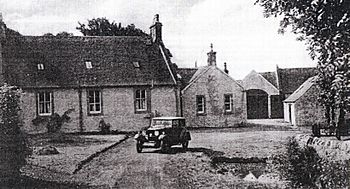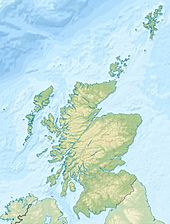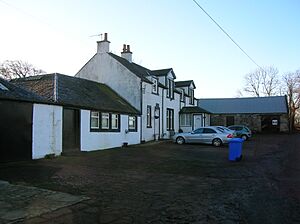Lands of Bogston facts for kids
Quick facts for kids Lands of Bogston |
|
|---|---|
| Beith, North Ayrshire, Scotland UK |
|

Bogstone Farm
|
|
| Coordinates | 55°43′43″N 4°36′57″W / 55.72867°N 4.61579°W |
| Grid reference | NS 35781 51453 |
| Type | Manor House |
| Site information | |
| Owner | Private |
| Controlled by | Clan Montgomery |
| Open to the public |
No |
| Condition | Demolished |
| Site history | |
| Built | 16th century |
| Built by | Montgomerie family |
| Materials | Stone |
Bogston, also known as Bogstone, was a small estate located near Barrmill in the area of Beith, North Ayrshire, Scotland. It was once part of the old Barony of Giffen. The land was owned by relatives of the Montgomerie family, who were important in the area. The estate covered about 160 acres (65 hectares).
Contents
Bogston House and Estate Features
Bogston House was the home of the Montgomerie family. It was located between South Barr, Hayhills, and Bogfaulds Farms, in what is now a military area called DM Beith. Bogston was a beautiful estate with many trees, orchards (fruit gardens), and lovely gardens.
A famous yew tree at Bogston was huge! When it fell in 1874, it was 38 feet tall, spread 50 feet wide, and its trunk was almost 10 feet around.
At first, people reached Bogston from a path near Gatend Farm. Later, around 1775, a main entrance was made from the road between Barrmill and Beith. This was when the house was being updated. The border between the parishes of Beith and Dalry runs nearby, partly along a boggy area called Bankhead.
Building and Improving the Estate
Robert Montgomery built a strong, simple house at Bogston in 1775. He also improved the land around it. He divided the land into fields, planted rows of trees, and created a long entrance path about a third of a mile long. Bogston House was one of the first homes in the area to have a slate roof, which was a modern feature back then.
A line of forest trees protected a large orchard with many fruit trees that surrounded the house on two sides. The gardens also had beautiful plants like lilac, laburnum, rhododendron, and daffodils. The large yew tree stood on the lawn in front of the house.
The Bogston Rookery
Bogston had a special rookery, which is a place where crows nest. It was unusual because the crows were encouraged to nest there by people tying sticks in the branches. This was one of the first times this was successfully done. It was noted that when Robert Wilson Montgomerie, also known as 'Bogston,' passed away, the crows left the rookery.
The Montgomerie Family of Bogston
Early Owners
Matthew Montgomerie of Bogston was known for his strength. He was a Covenanter, a group who supported a certain type of church in Scotland. Stories say he fought and defeated two soldiers who attacked him near Bankhead Moss. He also escaped from soldiers while attending church in Beith.
Bogston was part of the Giffen Barony. In 1663, the 7th Earl of Eglinton gave the land to Robert Montgomerie. However, the Montgomerie family had lived there even before this date. Robert was a relative of the Montgomeries of Broadstone and Giffen. He was very wealthy and important in the local area because he was the Earl of Eglinton's Baron Bailie (a type of local judge) for the Lordship of Giffen. He married four times.
Later Generations
Robert's oldest son, Matthew, inherited the property in 1682. Matthew married Janet Moor and had two children, Robert and Margaret. Sadly, Matthew passed away at age 27, before his father.
Matthew's son, Robert, had eighteen children, but fifteen of them passed away before him. His daughter, who was his heiress, married John Wilson. Their son, also named Robert, agreed to change his name to Montgomery to become his grandfather's heir. He became a merchant in Virginia in 1775 and returned nine years later. He lived to be 95 years old, passing away in 1832. A famous artist, Sir Henry Raeburn, painted Robert's portrait.
On April 26, 1784, Margaret Montgomerie, the youngest daughter of John Wilson, married Dr. Robert Borland at Bogston. Dr. Borland had earned a lot of money as a doctor and a plantation owner in Jamaica.
Robert Montgomerie of Bogston's son, also named Robert, inherited another property called Craighouse. His granddaughter married the Reverend John Witherspoon, who was a minister in Beith and later signed the United States Declaration of Independence.
Changes in Ownership
Robert Montgomerie Borland inherited Bogston. He lived in Prussia (now part of Germany) and only visited Bogston once in 1842. He borrowed money using the property as security and passed away in 1847 without marrying. His sister, Charlotte, then inherited the estate. She sold Bogston in 1848 to Margaret Gibson Spier, the widow of Robert Spier.
In 1926, the farm was sold to James Blair. In 1941, the land was bought by the Royal Naval Armaments Depot (RNAD) for military use. The buildings were demolished shortly after.
Bogstone Farm and Its End
After the sale in 1848, the mansion house and other buildings were changed and became part of a farm. The gardens were no longer cared for, and the orchard trees died. The famous yew tree suffered because it no longer had the protection of the surrounding trees, which were cut down.
In 1906, a short railway line was built to connect a nearby coal mine to the main railway line near Giffen station. In its final years, Bogston was a farm located near the Bombo Burn. A large area of land next to it was called 'Bogston Meadow' because the burn had been straightened.
After the military base was built, Bogston was completely demolished. Today, the area is only marked by a small group of trees.
In 1912, Bogstone was one of several farms owned by the Spier's Trust, which supported Spier's School. Representatives from the trust officially inspected the farm that year.



